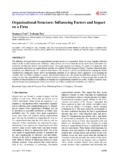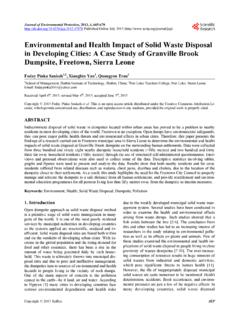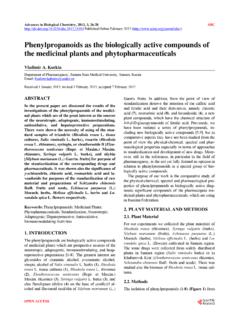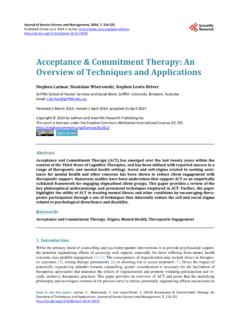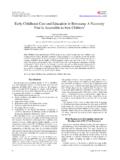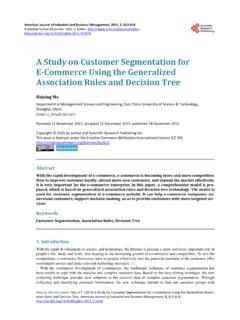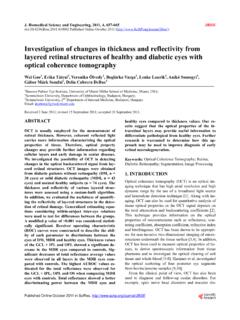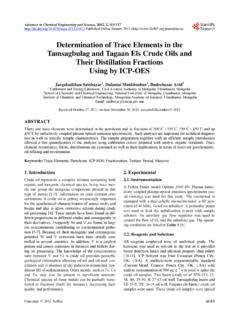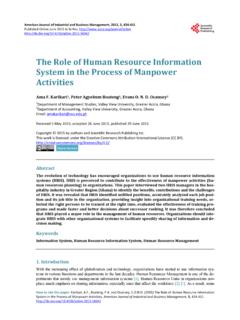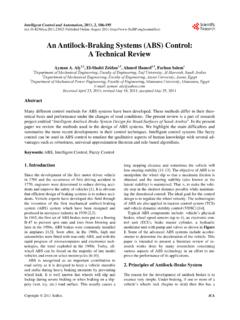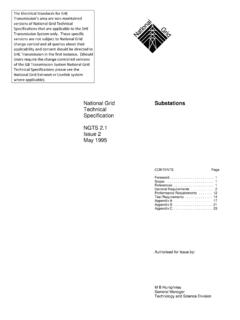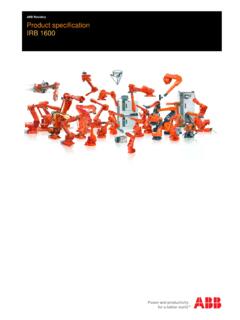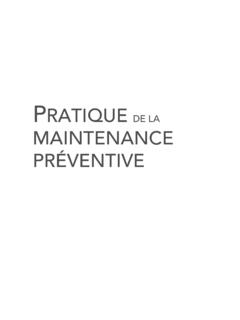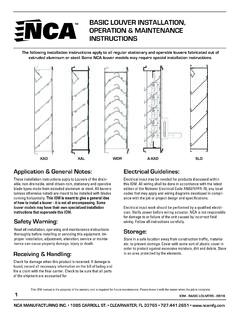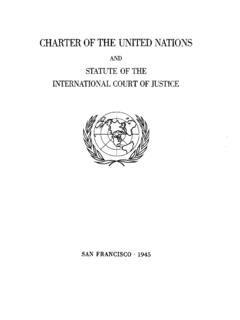Transcription of Reliability-Centered Maintenance Methodology and ...
1 Engineering, 2010, 2, 863-873. Published Online November 2010 ( ). Reliability-Centered Maintenance Methodology and Application: A Case Study Islam H. Afefy Industrial Engineering Department, Faculty of Engineering, Fayoum University, Al Fayyum, Egypt E-mail: Received September 15, 2010; revised September 27, 2010; accepted October 19, 2010. Abstract This paper describes the application of Reliability-Centered Maintenance Methodology to the development of Maintenance plan for a steam-process plant. The main objective of Reliability-Centered Maintenance is the cost-effective Maintenance of the plant components inherent reliability value.
2 The process-steam plant con- sists of fire-tube boiler, steam distribution, dryer, feed-water pump and process heater. Within this context, a Maintenance program for the plant is carried out based on this Reliability-Centered Maintenance concept. Ap- plying of the Reliability-Centered Maintenance Methodology showed that the main time between failures for the plant equipments and the probability of sudden equipment failures are decreased. The proposed labor program is carried out. The results show that the labor cost decreases from 295200 $/year to 220800 $/year (about of the total labor cost) for the proposed preventive Maintenance planning.
3 Moreover, the downtime cost of the plant components is investigated. The proposed PM planning results indicate a saving of about 80% of the total downtime cost as compared with that of current Maintenance . In addition, the pro- posed spare parts programs for the plant components are generated. The results show that about of the annual spare parts cost are saved when proposed preventive Maintenance planning other current mainte- nance once. Based on these results, the application of the predictive Maintenance should be applied. Keywords: Reliability, RCM, preventive Maintenance , FMEA, Case Study 1.
4 Introduction equipment failures and provide industrial plants with effective equipment [2]. RCM is one of the best known Steam system is an important part of many processing. and most used devices to preserve the operational effi- Maintenance , availability, reliability and total mainte- ciency of the steam system. RCM operates by balancing nance reliability cost are some of the most important the high corrective Maintenance costs with the cost of factors of steam-process plant. The plant provides heat programmed ( preventive or predictive) polices, taking energy to Egyptian Minerals and Salts Company (EMISAL), into account the potential shortening of useful life of EL-Fayoum, Egypt.
5 The main product of the company is the item considered. But it is difficult to select suitable sodium sulphate unhydrous and sodium chloride. Maintenance strategy for each piece of equipment and This work aims to generate a Maintenance program each failure mode, for the great quantity of equipment that based on the RCM technique for the process-steam and uncertain factors of Maintenance strategy decision plant components. This technique should be able to [3,4]. minimize the downtime (DT) and improve the availabil- RCM philosophy employs preventive Maintenance , ity of the plant components.
6 Also, it should benefits to predictive Maintenance (PdM), real-time monitoring decrease the spare parts consumption system compo- (RTM), run-to-failure (RTF) and proactive Maintenance nents. techniques is an integrated manner to increase the prob- RCM is a systematic approach to determine the main- ability that a machine or component will function in the tenance requirements of plant and equipment in its oper- ating [1]. It is used to optimize preventive Maintenance required manner over its design life cycle with a mini- (PM) strategies. The developed PM programs minimize mum of Maintenance [5,6].
7 Copyright 2010 SciRes. ENG. 864 I. H. AFEFY. 2. Reliability-Centered Maintenance System Selection and Data Collection Methodology Determining the list of the system components is one of Reliability-Centered Maintenance (RCM) is the optimum the first steps in RCM. The criticality analysis requires mix of reactive, time or interval-based, condition-based, different kind of data of each component that build up and proactive Maintenance practices. These principal the system. The effect of failure of the system main Maintenance strategies, rather than being applied inde- components may effect system productivity and mainte- pendently, are integrated to take advantage of their re- nance cost.
8 The factors effecting selection of critical sys- spective strengths in order to maximize facility and tem are as follows: 1) Mean-time between failures (MTBF). equipment reliability while minimizing life-cycle costs. 2) Total Maintenance cost. Total productive Maintenance (TPM), total mainte- 3) Mean time to repair (MTTR). nance assurance, preventive Maintenance , reliability- 4) Availability. centered Maintenance (RCM), and many other innovative approaches to Maintenance problems all aim at enhancing Logic Tree Analysis (LTA). the effectiveness of machines to ultimately improve productivity [7].
9 The basic (LTA) uses the decision tree structure shown in Figure 3. From this figure, decision bins: 1) safety- Reliability-Centered Maintenance related, 2) outage-related, or 3) economic-related were Components noticed. Each failure mode is entered into the top box of the tree, where the first question is posed: Does the op- The components of RCM program are shown in Figure 1. erator, in the normal course of his or her duties, know This figure showing that RCM program consists of (re- that something of an abnormal or detrimental nature has active Maintenance , preventive Maintenance , condition occurred in the plant?
10 It is not necessary that the operator based Maintenance , and proactive Maintenance ) and its know exactly what is awry for the answer to be yes [6]. patterns. As shown in Figure 2, the RCM steps are presented. Criticality Analysis The steps describe the systematic approach used to im- plement the preserves the system function, identifies Criticality analysis is a tool used to evaluate how equip- failure mode, priorities failure used to implement the ment failures impact organizational performance in order preserves the system function, identifies failure mode, to systematically rank plant assets for the purpose of priorities failure modes and performs PM tasks.
